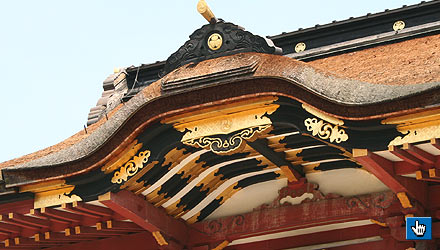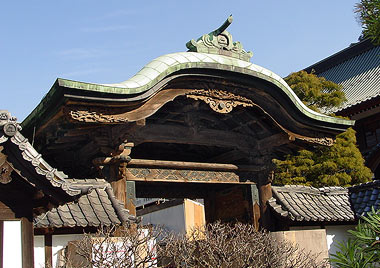|
|
| |
| karahafu 唐破風 |
 |
 |
 |
 |
| KEY WORD : architecture
/ general terms |
 |
| |
An undulating
bargeboard. The shape of a karahafu flows downward from the top center
with convex-curves on each side. As the roof descends the curves change
direction and form concave curves that level off at the ends or turn upward
to varying degrees. The lower center edge, just about where the concave
curves begin has a large board that is sometimes cusped *ibara
茨. Occasionally a gable pendant *gegyo
懸魚 is hung at the center top and called by its special name *unokedooshi
兎毛通. All the rafters curve to the same degree as the bargeboard. They are
called ibaradaruki 茨垂木. The miniature shrine *zushi
厨子 in the *Shouryouin
聖霊院 (ca 1278) at Houryuuji 法隆寺, Nara, is believed to be the oldest extant
example of karahafu. The karahafu appeared during the Heian
period and is depicted on the picture scrolls of the period as
being used for corridors, gates and palanquins. The term kara 唐 can
be translated as meaning 'China' it may instead have connoted elegance and
noble appearance. When the undulating gable is used at eave ends it is called
nokikarahafu 軒唐破風. It appears above entrances to temple buildings,
as gable ends on gates called *hirakaramon
平唐門 and when placed over a gateway entrance parallel to the ridge *munagi
棟木, it is called *mukaikaramon 向唐門. Undulating gables are used on
the front of a step-canopy *kouhai
向拝.
|
| |
| |
 |
nokikarahafu
軒唐破風:
a) karahafu 唐破風 b) *unokedooshi
兎毛通 c) *ibara
茨
Iga Hachimanguu Zuijinmon 伊賀八幡宮随身門 (aichi) |
| |
 |
|
Kenchouji Karamon 建長寺唐門 (Kanagawa) |
|
|
|
 |
 |
| REFERENCES: |
| *karamon
唐門, *chidori hafu
千鳥破風 |
 |
 |
 |
| EXTERNAL LINKS: |
| |
 |
 |
 |
| NOTES: |
|
|
 |
 |
 |
(C)2001 Japanese Architecture and Art Net Users System. No reproduction
or republication without written permission.
掲載のテキスト・写真・イラストなど、全てのコンテンツの無断複製・転載を禁じます。 |
| |




